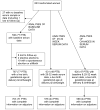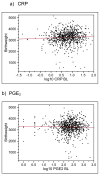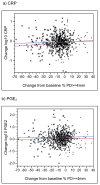Serum inflammatory mediators in pregnancy: changes after periodontal treatment and association with pregnancy outcomes
- PMID: 19905943
- PMCID: PMC2922720
- DOI: 10.1902/jop.2009.090236
Serum inflammatory mediators in pregnancy: changes after periodontal treatment and association with pregnancy outcomes
Abstract
Background: The purposes of this study were to determine: 1) if periodontal treatment in pregnant women before 21 weeks of gestation alters levels of inflammatory mediators in serum; and 2) if changes in these mediators are associated with birth outcomes.
Methods: A total of 823 pregnant women with periodontitis were randomly assigned to receive scaling and root planing before 21 weeks of gestation or after delivery. Serum obtained between 13 and 16 weeks, 6 days (study baseline) and 29 to 32 weeks of gestation was analyzed for C-reactive protein; prostaglandin E(2); matrix metalloproteinase-9; fibrinogen; endotoxin; interleukin (IL)-1 beta, -6, and -8, and tumor necrosis factor-alpha. Cox regression, multiple linear regression, and the t, chi(2), and Fisher exact tests were used to examine associations among the biomarkers, periodontal treatment, and gestational age at delivery and birth weight.
Results: A total of 796 women had baseline serum data, and 620 women had baseline and follow-up serum and birth data. Periodontal treatment did not significantly alter the level of any biomarker (P >0.05). Neither baseline levels nor the change from baseline in any biomarker were significantly associated with preterm birth or infant birth weight (P >0.05). In treatment subjects, the change in endotoxin was negatively associated with the change in probing depth (P <0.05).
Conclusions: Non-surgical mechanical periodontal treatment in pregnant women, delivered before 21 weeks of gestation, did not reduce systemic (serum) markers of inflammation. In pregnant women with periodontitis, levels of these markers at 13 to 17 weeks and 29 to 32 weeks of gestation were not associated with infant birth weight or a risk for preterm birth.
Conflict of interest statement
The authors report no conflict of interest.
Figures






Similar articles
-
Intrapregnancy non-surgical periodontal treatment and pregnancy outcome: a randomized controlled trial.J Periodontol. 2013 Oct;84(10):1391-400. doi: 10.1902/jop.2012.120572. Epub 2012 Dec 13. J Periodontol. 2013. PMID: 23237583 Clinical Trial.
-
Periodontal bacterial profiles in pregnant women: response to treatment and associations with birth outcomes in the obstetrics and periodontal therapy (OPT) study.J Periodontol. 2008 Oct;79(10):1870-9. doi: 10.1902/jop.2008.070554. J Periodontol. 2008. PMID: 18834241 Clinical Trial.
-
Effect of nonsurgical periodontal therapy on serum and gingival crevicular fluid cytokine levels during pregnancy and postpartum.J Periodontal Res. 2013 Feb;48(1):126-33. doi: 10.1111/j.1600-0765.2012.01513.x. Epub 2012 Jul 27. J Periodontal Res. 2013. PMID: 22835005 Clinical Trial.
-
Association of Chlorhexidine Use and Scaling and Root Planing With Birth Outcomes in Pregnant Individuals With Periodontitis: A Systematic Review and Meta-analysis.JAMA Netw Open. 2022 Dec 1;5(12):e2247632. doi: 10.1001/jamanetworkopen.2022.47632. JAMA Netw Open. 2022. PMID: 36534397 Free PMC article.
-
Suppression of the febrile response in late gestation: evidence, mechanisms and outcomes.J Neuroendocrinol. 2008 Apr;20(4):508-14. doi: 10.1111/j.1365-2826.2008.01666.x. Epub 2008 Feb 8. J Neuroendocrinol. 2008. PMID: 18266941 Free PMC article. Review.
Cited by
-
Interaction between stress, cytokines, and salivary cortisol in pregnant and non-pregnant women with gingivitis.Clin Oral Investig. 2021 Apr;25(4):1677-1684. doi: 10.1007/s00784-018-2569-9. Epub 2018 Jul 31. Clin Oral Investig. 2021. PMID: 30066030
-
Salivary and serum inflammatory mediators among pre-conception women with periodontal disease.BMC Oral Health. 2016 Dec 15;16(1):131. doi: 10.1186/s12903-016-0306-9. BMC Oral Health. 2016. PMID: 27978823 Free PMC article.
-
Periodontitis, cardiovascular disease and pregnancy outcome--focal infection revisited?Br Dent J. 2014 Oct;217(8):467-74. doi: 10.1038/sj.bdj.2014.903. Br Dent J. 2014. PMID: 25342358 Review.
-
The bidirectional relationship between periodontal disease and pregnancy via the interaction of oral microorganisms, hormone and immune response.Front Microbiol. 2023 Jan 26;14:1070917. doi: 10.3389/fmicb.2023.1070917. eCollection 2023. Front Microbiol. 2023. PMID: 36778874 Free PMC article. Review.
-
The influence of nonsurgical periodontal therapy on the occurrence of adverse pregnancy outcomes: A systematic review of the current evidence.J Indian Soc Periodontol. 2020 Jan-Feb;24(1):7-14. doi: 10.4103/jisp.jisp_228_19. Epub 2020 Jan 2. J Indian Soc Periodontol. 2020. PMID: 31983838 Free PMC article. Review.
References
-
- Hamilton BE, Martin JA, Ventura SJ. Births: preliminary data for 2005. Natl Vital Stat Rep. 2006;55(11):1–18. - PubMed
-
- Behrman RE, Butler AS Institute of Medicine. Preterm birth: causes, consequences, and prevention. Washington, D.C: National Academies Press; 2007. Committee on Understanding Premature Birth and Assuring Healthy Outcomes; p. 772. - PubMed
-
- Romero R, Gomez R, Chaiworapongsa T, Conoscenti G, Kim JC, Kim YM. The role of infection in preterm labour and delivery. Paediatr Perinat Epidemiol. 2001;15 (Suppl 2):41–56. - PubMed
Publication types
MeSH terms
Substances
Grants and funding
LinkOut - more resources
Full Text Sources
Medical
Research Materials

